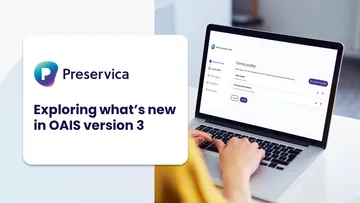What you need to know about the recent updates in OAIS v3
 Jack O'Sullivan
•
April 3, 2025
Jack O'Sullivan
•
April 3, 2025

The OAIS (Open Archival Information System) reference model has been a guiding light in Digital Preservation for decades, helping organizations keep their digital content accessible and understandable over time. But as technology evolves, so do the challenges of preservation—so it’s no surprise that the model itself has gotten an upgrade.
In December 2024, the Consultative Committee for Space Data Systems (CCSDS) released the third edition of the OAIS Reference Model, bringing some important updates that better align with today’s preservation needs. This latest version introduces clearer definitions of preservation goals, a new concept called Preservation Watch, and more flexible ways to structure Information Packages—just to name a few.
In this post, we’ll break down the key changes in the 2024 update, explain why they matter, and show how Preservica’s Active Digital Preservation solutions align with these new standards.
Background of OAIS and ISO
Established in 1999, the OAIS Reference Model became an ISO standard (ISO 14721) in 2003. It provides a comprehensive framework for organizations to understand and implement Digital Preservation processes, encompassing the entire lifecycle of digital objects—from ingestion to access.
The model has undergone revisions to address emerging challenges and incorporate feedback from the preservation community, with the latest update being a culmination of extensive discussions and developments over several years.
Key updates in the latest OAIS revision
The December 2024 update introduces several substantive changes aimed at enhancing the model's applicability and effectiveness:
- Definition of Preservation Objectives
The updated model emphasizes the importance of clearly defined preservation objectives. These objectives serve as measurable assertions about what aspects of digital content an organization aims to preserve. By establishing these objectives upfront, organizations can better assess the success of their preservation efforts and make informed decisions regarding acceptable levels of loss or change over time.
- Introduction of Preservation Watch
A notable addition is the concept of Preservation Watch, which underscores the necessity of continuous monitoring within the preservation environment. This function involves keeping abreast of technological advancements, evolving user needs, and potential risks that could impact the accessibility or integrity of preserved digital objects. By proactively monitoring these factors, organizations can implement timely interventions to mitigate risks and adapt to changes.
- Modification of Information Object Definitions
The update refines the definitions of several key components—Representation Information, Other Representation Information, Representation Information Network, Packaging Information, Package Description, and Preservation Description Information—by categorizing them as types of Information Objects. This reclassification acknowledges the complexity and interrelatedness of these components, ensuring that each is accompanied by appropriate Representation Information to facilitate understanding and usability.
- Redefinition of Information Package Structure
The structure of the Information Package has been revised to offer greater flexibility. Previously defined as Content Information coupled with its associated Preservation Description Information (PDI), the new definition allows an Information Package to comprise one or more optional Information Objects, making PDI optional in certain contexts. This change supports approaches like "ingest first, describe later," enabling organizations to prioritize the timely ingestion of digital objects while deferring detailed descriptions to a later stage.
- Acknowledgment of Evolving Representation Information
The update recognizes that Representation Information may need to evolve over time to accommodate changes in the Designated Community's knowledge base. For instance, while current users might readily understand formats like TIFF, future users may require additional context or tools to interpret these formats. This acknowledgment reinforces the necessity for ongoing updates to Representation Information to maintain the intelligibility and usability of preserved digital objects across generations.
How Preservica aligns with the latest OAIS updates
The latest updates to the OAIS model reinforce the principles that Preservica has championed over many years as well as the way we have architected our Active Digital Preservation platform. At its core, Digital Preservation isn’t just about storing files—it’s about ensuring they remain accessible and meaningful as technology and user needs evolve. OAIS version 3 acknowledges this reality, bringing the model closer to Preserica’s approach.
Preservica’s Active Digital Preservation software is built around automation, ensuring files don’t just sit in an archive but are actively monitored and updated on an on-going basis to ensure accessibility. From the moment a file is ingested, Preservica can automatically convert it into preservation-friendly formats, and then importantly, continue to check and automatically update files at risk of obsolescence. This active approach aligns perfectly with the updated OAIS model’s push for ongoing preservation actions rather than static one-time approaches that risk files being unreadable when needed.
Another key update in OAIS is the concept of Preservation Watch, which formalizes the idea that preservation isn’t a set-it-and-forget-it task. Preservica has long recognized the need for continuous monitoring, which is why our expert team of file format analysts works with the community to monitor changes in the evolving technology landscape and shifts in user knowledge. If a file format becomes outdated, a new rendering tool emerges, or the Preservation Objectives change, Preservica’s master registry can be adjusted accordingly, and changes pushed automatically to customers, updating the metadata and Representation Information and migrating to new formats aligned to the customer’s chosen preservation policy to ensure long-term access to instantly usable content.
The updated OAIS model also embraces a more flexible approach to ingestion, something Preservica has supported over many years. Sometimes, the priority is to get digital content preserved quickly, even if all the descriptive details aren’t available right away. The Preservica platform allows for "ingest first, describe later", meaning organizations can capture content immediately and enrich its metadata over time, a shift that the latest OAIS revision explicitly supports.
Finally, metadata management remains at the heart of both Preservica’s approach and the OAIS framework. The new version clarifies the role of Representation Information and Preservation Description Information, making it clear that these elements need to evolve alongside digital assets. Preservica’s robust metadata management tools ensure that every component of an Information Package is properly documented and updated as needed, keeping digital content usable for future generations.
With these OAIS updates, Digital Preservation is stepping into the future—and it’s a future that Preservica’s Active Digital Preservation software has already been architected to support.
Curious about how these changes impact your preservation efforts?
Contact us to discuss your Digital Preservation requirements with our experts
Learn more:
Free to download Digital Preservation White Paper series
Build your Digital Preservation skills by enrolling on our free Academy




